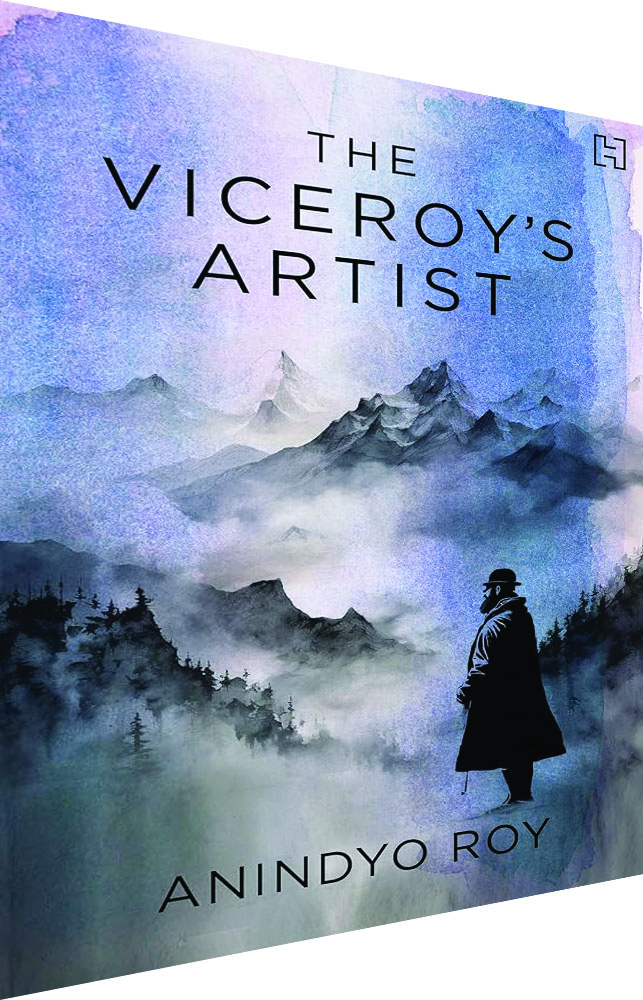 The Viceroy’s Artist
The Viceroy’s Artist
Anindyo Roy
hachette india
Rs.599
Pages 284
A 19th century travelogue across India of Edward Lear, a nonsense- verse writer and sketches painter, is pieced together by academic-turned- novelist Anindyo Roy
Who is the Viceroy and who is his artist is played out over 284 pages of this historically contextualised tour de force fictionalised debut novel authored by senior academic-turned-novelist, Anindyo Roy. Lord Northbrook (Thomas Baring), Viceroy of India (1872-1876) cocooned in Government House, a building described as an “epitome of opulence,” commissioned Edward Lear, artist and limerick writer, to paint the Himalayas, especially the mesmerising Kanchenjunga range for him.
Lear, a nonsense-verse writer travelled across India and Sri Lanka in 1873-75, scribbling in his journal and painting sketches in sepia-tinted water colours. Roy chanced upon Lear’s journal archived in Harvard University and was fascinated by what the artist inscribed and matter he relegated to parentheses, articulations and silences. From the study of Lear’s journal, Roy has deduced the story of Lear — an individual haunted by loneliness, ill-health and deprivation, but blessed with a child-like imagination, an artist’s spatial vision and perspective, and sensibility to objectify the humour of everyday life while depicting the eccentricities of friends and acquaintances.
Linearity of Lear’s travels as pieced together by Roy is fragmented in the telling by embedding historical events or experiences in moments of recall, unravelling memories and venturing on journeys in other times and spaces. When Lear with his Italian valet-cum-travel companion, Giorgi, explores Delhi with their native guide Nunkoo Lal, the latter gushes over Delhi describing this Moghul heritage sadly laid waste by arson as a “truly glorious city, rivalling Rome”. This transports the author back to the agonising post-Mutiny debate in Britain 150 years ago, whether the Indian Empire should be retained or abandoned.
Roy perceptively identifies the fissures and cracks in the edifice of the British Empire at its height. He fleshes out the personality of the artist, his compassion and uncomfortable sense of guilt disturbed by inevitable colonial stereotyping while recounting Mutiny folklore — the valour of British soldiers and generals, the savagery of natives.
Lear’s impatience with trivial details of the memsahib’s (Mrs. Cracroft) everyday life in exile, is countered by his wandering mind and deep concern about “devastation in its rawest — arson, bloodshed and famine” — that was the reality of the British Empire in India. This peek behind Raj glamour and splendour exposes colonial power to postcolonial interpretations that underline the artist’s vision and humour.
Based on his India journals, the novelistic resurrection of Edward Lear, the artist/protagonist, takes a serendipitous path, attempting to fill in gaps and silences, unravelling traumas and inadequacies to revive innumerable half-told stories.
The storyteller’s imagination is easily ignited by hints and clues while interacting with Brits and natives in far-flung outposts of the Empire, the hill-stations and dak bungalows. Influential characters like Evelyn Baring (the viceroy’s secretary), Franklin Lushington (judge of the Supreme Court of justices in the Ionian islands), Chichester Fortesque (Member of Parliament from Ireland), Edgar Ware (assistant commissioner of Kurseong) make cameo appearances through Lear’s remembered interactions. Memories of childhood and adolescence creep in without notice — sister Ann appears as a surrogate mother, beloved Gussie as a much-desired companion.
The novel successfully recreates the material texture of Victorian life and culture through nuanced quotations and references to Tennyson and his poetry, Hooker and his botanising in the eastern Himalayas, Christina Rossetti and her ‘Goblin Market’, Pre-Raphaelite painters Holman Hunt and Dante Gabriel Rossetti, Lockwood Kipling in Bombay, and curiosity about his curations and artwork.
Though a fairly slow-moving novel, the drama lies in the novelist’s use of the stream of consciousness technique at two levels. While depicting Lear, the artist who frequently relapses into memory, limericks, imagination, meditation, Roy excavates journal entries about Lear’s experiences that are intrinsic to the journey presented in the novel. This in-and-out consciousness is structurally integrated through large portions of the narrative by being inscribed in italics.
The Viceroy’s Artist is not merely a novel, but a volume that at varied levels delves into language and landscape, imperial politics and missionaries, colonial rulers with retinues of native servants, a world of adults as well as innocent children. Sourav Roy’s pen-sketches in imitation of Lear’s limerick illustrations appear as epigraphs to the chapters, reminding us of Lear’s popularity with children — Anne and Manjoo’s ‘favouritest poem’ being ‘The Owl and the Pussycat’.
Finally, Edward Lear emerges not entirely as the Viceroy’s artist but as a multi-talented personality whose popularity as the creator of British nonsense verse, inspired a genre represented by Abol Tabol, Sukumar Ray’s classic Bengali book of nonsense poems.
Jayati Gupta




























